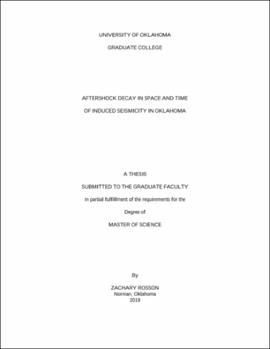| dc.description.abstract | The current paradigm for estimating long-term seismic hazard in a region includes removing dependent earthquakes that occur after a mainshock, otherwise known as aftershocks, from an earthquake catalog to identify the underlying background Poissonian-like seismicity rate. In Oklahoma, attempts to quantify the seismic hazard are complicated by the 200-fold increase in the seismicity rate in the last decade, where 901 earthquakes of M3.0 and greater occurred in 2015 against a pre-2009 historical seismicity rate of just a few M3.0 and greater earthquakes per year. Thus, it is unclear how one would assess the current seismic hazard in Oklahoma with conventional methods for declustering. To examine the usefulness of declustered catalogs of Oklahoma seismicity in hazard modeling, one must first scrutinize the parameters used in the declustering procedures. In this study, we work under the conceptual framework of identifying aftershocks using fixed space-time windows that are scaled by mainshock magnitude. We then use techniques to examine how aftershocks decay in space and time, and compile data-driven distance-time cutoffs which can be used as parameters for fixed-window declustering of Oklahoma seismicity. Our approach also allows us to observe that the decay of aftershocks in space is more rapid in Oklahoma than in Southern California, while the decay of aftershocks in time is indistinguishable between the two regions. These observations may suggest that Oklahoma has a smaller fractal dimension of its fault network and temporal aftershock decay controlled by induced pressure changes more than tectonic stresses. Most importantly, since inadequately parameterized aftershock identification windows can ultimately under- or over-estimate the regional seismic hazard, our results speak to the necessity of well-founded declustering parameters for seismic hazard assessment, especially in regions of induced seismicity. | en_US |

